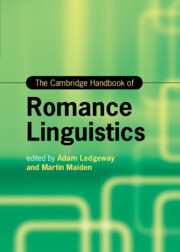Book contents
- The Cambridge Handbook of Romance Linguistics
- Cambridge Handbooks in Language and Linguistics
- The Cambridge Handbook of Romance Linguistics
- Copyright page
- Dedication
- Contents
- Figures
- Tables
- Contributors
- Abbreviations
- 1 Data, Theory, and Explanation: The View from Romance
- Part One What Is a Language?
- Part Two Phonetics and Phonology
- 5 Structure of the Syllable
- 6 Sandhi Phenomena
- 7 Effects of Stress
- 8 The Notion of the Phoneme
- 9 Typologically Exceptional Phenomena in Romance Phonology
- Part Three Morphology
- Part Four Syntax
- Part Five Semantics and Pragmatics
- Part Six Language, Society, and the Individual
- Index
- References
6 - Sandhi Phenomena
from Part Two - Phonetics and Phonology
Published online by Cambridge University Press: 23 June 2022
- The Cambridge Handbook of Romance Linguistics
- Cambridge Handbooks in Language and Linguistics
- The Cambridge Handbook of Romance Linguistics
- Copyright page
- Dedication
- Contents
- Figures
- Tables
- Contributors
- Abbreviations
- 1 Data, Theory, and Explanation: The View from Romance
- Part One What Is a Language?
- Part Two Phonetics and Phonology
- 5 Structure of the Syllable
- 6 Sandhi Phenomena
- 7 Effects of Stress
- 8 The Notion of the Phoneme
- 9 Typologically Exceptional Phenomena in Romance Phonology
- Part Three Morphology
- Part Four Syntax
- Part Five Semantics and Pragmatics
- Part Six Language, Society, and the Individual
- Index
- References
Summary
The primary interest of sandhi in Romance is as a morphological phenomenon. Adaptation of word forms to a variety of sandhi contexts gives rise to allomorphy (paradigmatic variation). Such adaptation reflects natural phonological processes which tend to reduce the markedness of sequences of phonological elements. We illustrate from Catalan and French strategies to avoid hiatus, and from Catalan and Occitan strategies to simplify consonant clusters. Romance also attests subphonemic alternations in sandhi environments, and we draw attention to cases such as intersonorant lenition of initial voiced stops in much of south-western Romance. A striking feature of Romance sandhi alternations is the readiness with which they may become morphologized or lexicalized. This outcome may arise from subsequent sound changes that make the original motivated alternation opaque, or from levelling of allomorphic alternation that makes the distribution of allomorphs opaque. We review an example of such a change in progress: the aspiration/loss of coda /s/ in Andalusian Spanish. Occasionally, a morphologized/lexicalized alternation may be (partly) remotivated, as is famously the case with rafforzamento fonosintattico ‘phonosyntactic strengthening’ in standard Italian. However, the phenomena of elision and liaison in modern French exemplify morphophonemic arbitrariness with very extensive incidence.
- Type
- Chapter
- Information
- The Cambridge Handbook of Romance Linguistics , pp. 209 - 233Publisher: Cambridge University PressPrint publication year: 2022



